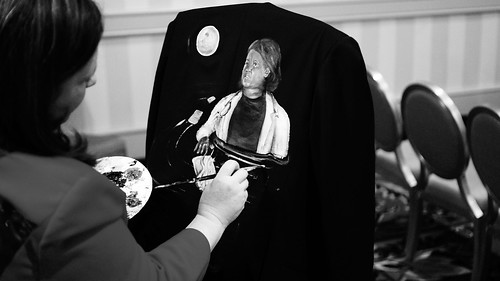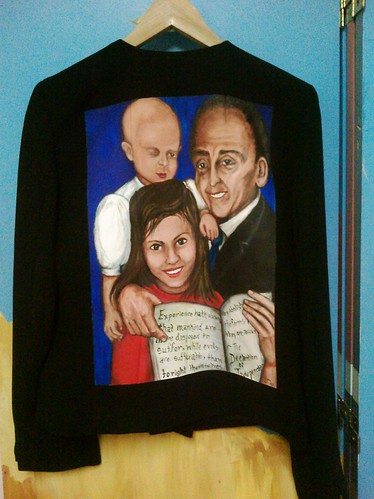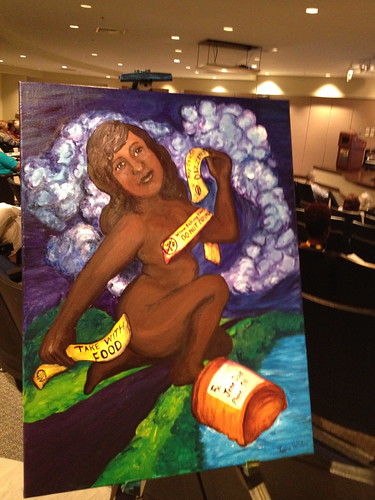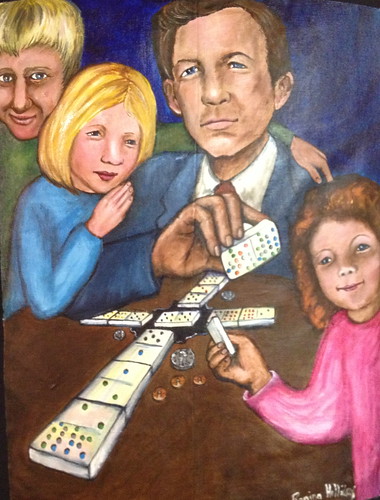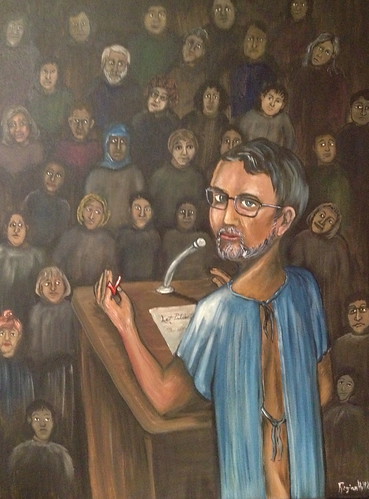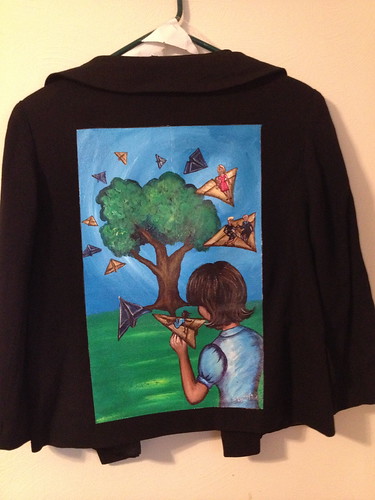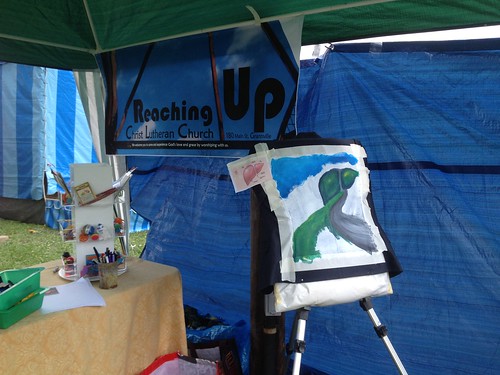On Friday I was painting a picture of blood in a park.
It is a beautiful painting that seems at first serene, but as one looks upon it more deeply there is an undercurrent of stress. It is the jacket painting of Gina Neff. The title is “Under Pressure. “ I painted this painting under a deadline. I would be giving it to Gina at the Health Foo gathering in Boston that evening. I painted while listening to an NPR report an ever-widening lock down in Boston. There was a manhunt for the two fugitives who were believed to be behind the Boston Marathon bombing several days before.
It is a beautiful painting that seems at first serene, but as one looks upon it more deeply there is an undercurrent of stress. It is the jacket painting of Gina Neff. The title is “Under Pressure. “ I painted this painting under a deadline. I would be giving it to Gina at the Health Foo gathering in Boston that evening. I painted while listening to an NPR report an ever-widening lock down in Boston. There was a manhunt for the two fugitives who were believed to be behind the Boston Marathon bombing several days before.
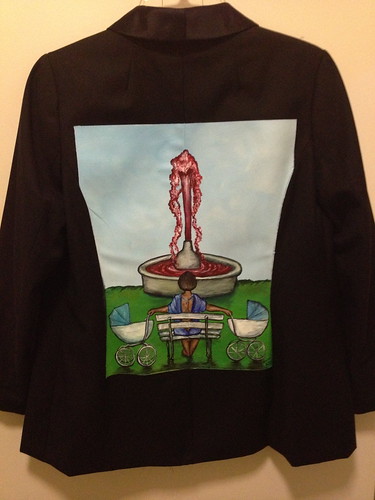
So I painted blood where it should not be. Gushing in the park.
Gina Neff suffered from preeclampsia when her twin boys were born. Her blood pressure was dangerously high after the births and did not return to normal levels for weeks afterward. There was a danger she would have chronic severely elevated high blood pressure whilst caring for twin newborns. So she is painted with the stress of pushing two carriages while her blood pounds within her.
Then normality returned to Gina’s life. One day her heart calmed and the world continued.
As I put the finishing touches on this painting, I listened to the growing tension in Boston. I checked my email to see if the Health Foo event was still on. It was still a go, so I threw my clothes in one bag and threw my paints into another. I then received an email from my friend Susannah Fox who was also going. I was supposed to room with her that night. She wrote to say she had re-booked her flight for the following morning. Okay, I thought. Now, I had no place to stay. Hopefully, the hotel would have spare rooms. I lugged my bags to the curb and hailed a cab. Then I called my friend Ted Eytan. He assured me he was still going, so I responded if the two of us were going to be there, the conference would go on.
When I landed in Boston I checked my email to see that event had been cancelled due to the continued lock down. I waited for Ted’s plane to land and followed the tweet stream for #healthfoo. Danielle Cass had just flown in from California and did not relish the idea of heading right back. When Ted landed we both encouraged Danielle to stay as no matter what. This event should not be derailed.

That evening the remaining members of Health Foo met at the Royal Sonesta Hotel for light refreshments and drinks. I walked over to Gina Neff and handed over her new gallery jacket and was told I could room with her that night. What amazing friends we have within the world of health and social media! Soon Sara Winge VP of O’Reilly Radar group and co-founder of Foo Camp came carrying her sorrow and a box of books for attendees. The other materials were locked up inside our closed venue. We had no nametags, no markers and none of the supplies to rebuild an event from the ground up
That did not stop us.

We borrowed a white board from the hotel and began to plan the next day’s event. Sara got us started with a few words. Then we did the traditional introductions of each attendee around the room. We decided that the next day we would begin by having brunch. Then we would walk around Boston for a few hours as a Walking Foo (or Walking meeting). Then we would meet around 2 and hopefully have a venue by then. Several local attendees would ask around to try to find a place that would allow us to meet with no notice. We would communicate the real time status of the event on Twitter, Facebook and through texts and anyone who wanted to join us was invited!!
Next we proposed session topics. We filled the unconference board and decided to present a few ignite speeches without slides. Danielle Cass’s speech about work life balance and her new role at Kaiser Permanente was a type of catharsis for her and many other struggling souls in that room. She was brilliant. Our unconference sessions continued until Sara told us the hotel needed the room back and then our excited conversations continued in the hotel lobby well past mid-night.

 The next day was Saturday and the Health Foo group split into two parts, some of us eating brunch at Friendly’s and some at Area Four on Main Street.
The next day was Saturday and the Health Foo group split into two parts, some of us eating brunch at Friendly’s and some at Area Four on Main Street.Very soon each group set out walking. We were blessed to have 15-year-old Abigail Boone in our group. As her father Keith Boone was willing to let her walk with us while he was in the other group.
We came across the make shift memorial for the fallen MIT officer. As we stood there taking photos, Abigail drew a small picture and laid it down as a gift upon the growing mound of flowers. Then we walked away.
We walked as octopus navigates the ocean floor, our form changing and reforming. I would talk with Ted, then Hugh, then Danielle Cass, then Danielle Gould, then Chach and then Abigail... Abigail is a student studying forestry and as she walked beside me she explained the growth of calluses on trees and pointed to ‘cancer’ on a trunk. I walked in awe beside her. I learned so much from a 15-year-old girl who would have never talked with me if this had been a traditional Health Foo.
Soon we met with the other group coordinating via twitter and Google maps. Anna Young from Little Devices told us she thought she could get us into a space at MIT. We walked over to the new space. It was perfect! We filled out another unconference planning board Fred Trotter took charge of this process and was amazing. I attended Ted Eytan’s session on transgender experiences and I began to paint.

This is the painting “The Open Door.”

This is the Boston I saw upon arrival: the streets devoid of cars and the buildings in lock down. Then the campers begin to walk upon the street as it buckles and bends in a crazy life ride. In the distance there is an open door on a building marked MIT.

One walker holds a transgender hula-hoop. A hula-hoop is toy that is only enjoyed while in constant motion. Always recalibrating to keep it up. I thought it a good metaphor for the constant frustrations of the transgender patient seeking medical care and respect.
Soon Hugh Montgomery would talk with us about climate, global warming and the power of wind energy, explaining that if Tylenol would just become available in smaller milligram tablets it would save energy in manufacture.
 I began to paint the police tape that littered the ground as we walked earlier that day. It had joined the piles of windblown trash that made Abigail so sad as she saw the waste of our industrial world overlaying the roots of her beloved trees. We then talked about the future of education and a little red schoolhouse entered the picture. Soon it was 6:00pm and time to wrap up this conference day. I went to dinner with Ian Eslick and several other amazing campers and we talked about programming code a good part of the evening.
I began to paint the police tape that littered the ground as we walked earlier that day. It had joined the piles of windblown trash that made Abigail so sad as she saw the waste of our industrial world overlaying the roots of her beloved trees. We then talked about the future of education and a little red schoolhouse entered the picture. Soon it was 6:00pm and time to wrap up this conference day. I went to dinner with Ian Eslick and several other amazing campers and we talked about programming code a good part of the evening. The next day I met Ted for breakfast and happily looked back on the weekend thus far. We were so glad that we had been able to encourage others to embrace the failure of a plan and build something great from the remains. I told Ted, this wasn’t that hard for a patient to do; after all, we have nothing upon entering the world of care. We have no space to call our own; we constantly must move, never sure where we will end up next. A Health Foo unconference created on the go was nothing new to the patient and family caregiver; it was the care model as we knew
it.
Soon Ted and I met the small Sunday morning crowd at MIT. Ted proposed a session to teach those who did not know how to tweet the wonders of twitter. Ted took Hugh Montgomery under his wing and I began explaining Twitter to Gorden Bell. He then showed me his self-tracking devices, which I tweeted out to the world. By the time an hour had past both gentleman were sending tweets and following accounts.

I returned to my painting and painted two young men building a go-kart on the left of the painting just as they were doing in the left of the room. Then I participated in a final session on the importance of tracking heart rate variability. The session was presented by an engineer and given to two doctors, another engineer and to this artist who only attained a high school degree.
That was pure Health Foo.
You see Health Foo brings us together: the smart techie, the artist, the doctor, the designer. In this moment we are all equal. We are all valued and from each of our singular natures we make a greater whole.
So I signed this piece and gave it to Anna Young for her willingness to host us inside her maker space. She was so happy she began to cry. Her whole face beamed with joy. Her blue eyes were an endless sparkling chasm; an open door. For when Anna unlocked the door to MIT that day she created a moment of communion and we are all greater for it.

As my friend Ted has said, It is the greatest cancelled event I have ever attended. It was an amazing weekend. It was a moment to recharge the batteries of so many of us who after weeks or months of travel and teaching needed to feel the embrace of great friends and agile minds.
We found in this gathering the peace that Gina found in her post partum home. We found the peace that I hope Boston will find as well. Our hearts calmed and the world continued.


